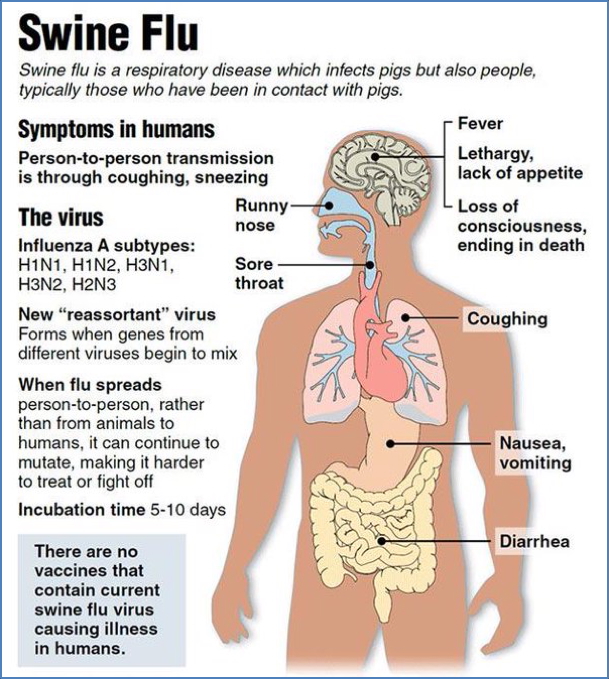Table of Contents
Overview – Swine Flu (H1N1)
Swine flu (H1N1) is a subtype of influenza A virus that caused a global pandemic in 2009. Though initially feared due to its novel genetic makeup, it has since become part of seasonal flu strains with generally low mortality. The virus spreads via respiratory droplets and commonly affects children, the elderly, and immunocompromised individuals.
Definition
Swine flu refers to respiratory illness caused by the H1N1 strain of influenza A virus, which originated from a combination of swine, avian, and human flu genes.
Aetiology
- Influenza A H1N1 virus
- A novel strain combining genetic material from five different influenza viruses
- Now considered part of seasonal flu viruses
Epidemiology
- Spread human-to-human via respiratory droplets (not via pigs)
- Affected populations: young children (<5 years), elderly (>65 years), immunocompromised
- Incubation period: 1–2 days
- Early pandemic concern led to unnecessary mass pig culling in some areas
Pathogenesis
- Droplet transmission from infected individuals
- Viral replication in the respiratory epithelium
- Epithelial damage leads to typical flu-like symptoms
Clinical Features
Symptoms
- Fever, chills
- Cough, sore throat
- Headache, myalgia, arthralgia
- Nausea, vomiting, diarrhoea (in ~25% of cases)
Signs
- Generally mild symptoms in most
- Rare severe cases may develop pneumonia or ARDS
Emergency Warning Signs
In Children:
- Laboured breathing, cyanosis
- Dehydration
- Fever with rash
- Lethargy or irritability
In Adults:
- Shortness of breath
- Chest or abdominal pain
- Confusion
- Persistent vomiting

Diagnosis
- Clinical suspicion based on symptoms and epidemiology
- PCR testing of nasal, nasopharyngeal, or oropharyngeal swabs
- Notify public health authorities
- Initiate contact tracing and quarantine if necessary
Management
- Supportive care:
- Fluids
- Paracetamol
- Rest
- Antivirals (effective if given within 48 hours of symptom onset):
- Oseltamivir (Tamiflu®)
- Zanamivir (Relenza®)
Summary – Swine Flu (H1N1)
Swine flu (H1N1) is a human-adapted influenza virus that spreads via respiratory droplets, causing a typically self-limiting illness with flu-like symptoms. Early treatment with antivirals may reduce symptom duration, and public health notification is key in suspected outbreaks. For broader context, visit our Respiratory Overview page.